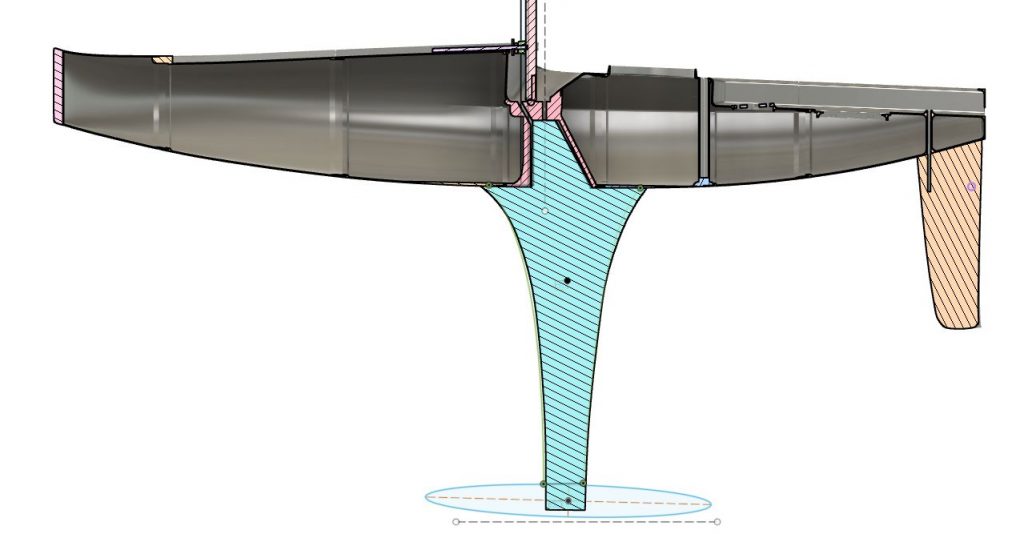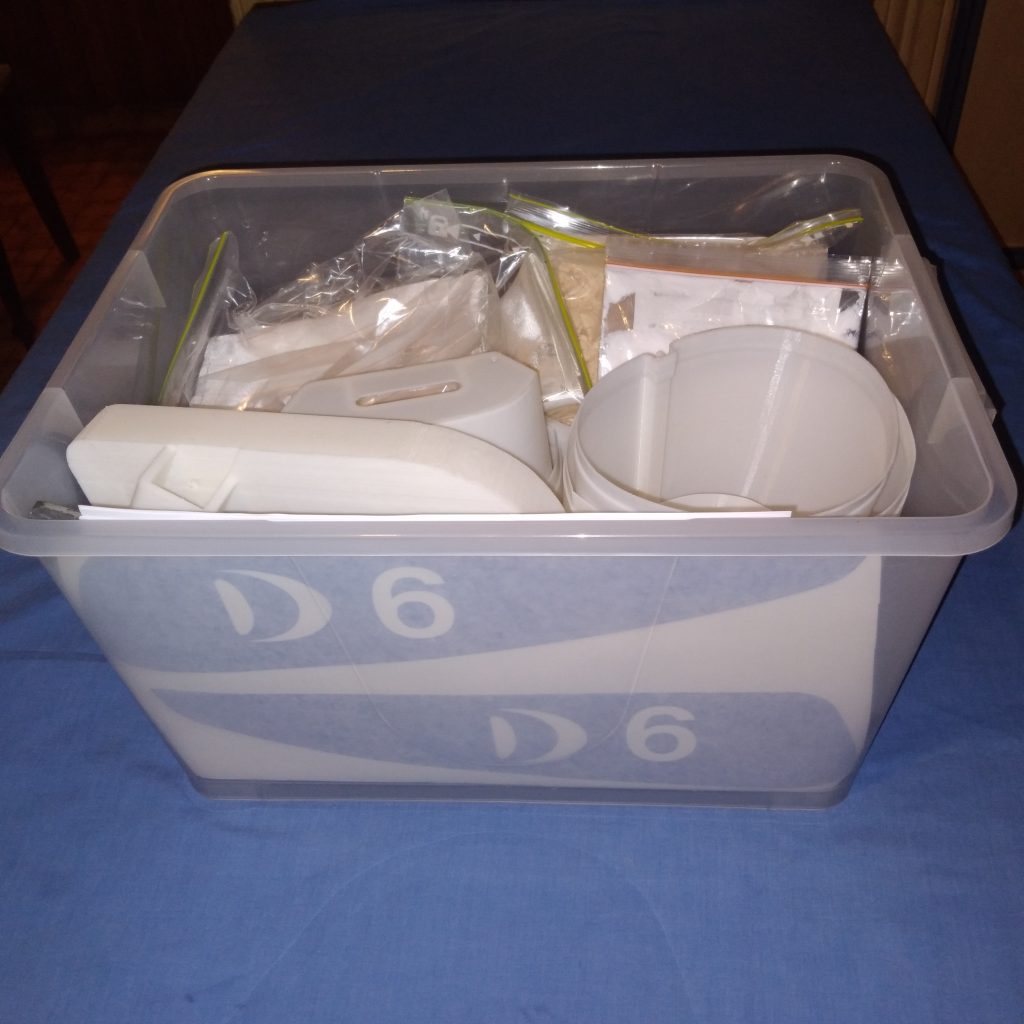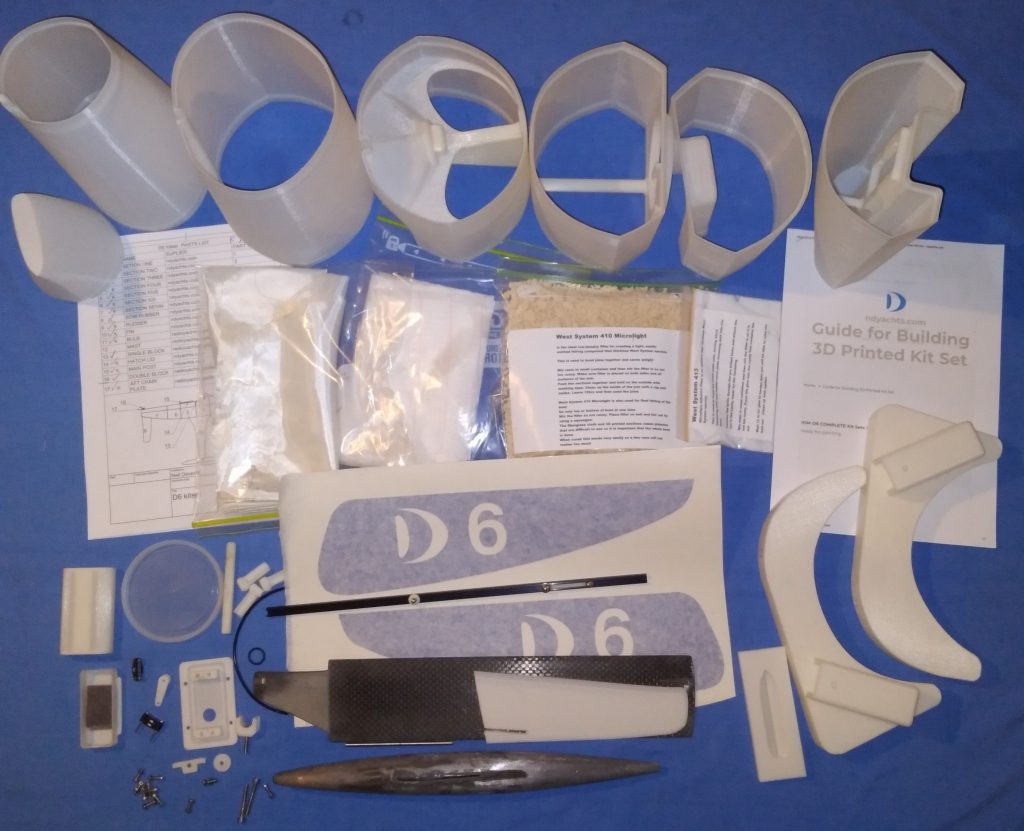IOM D6 COMPLETE Kit Sets have all component’s for building a hull that is ready for painting.

However, you will have to buy epoxy resin, sandpaper, masking tape, methylated spirits, squeegee, 25mm disposable brush and paint.


Steps for assembly
1/ Fit and glue nuts for fittings
Glue in nuts for block fastening, rudder servo fastenings, and chain plates. You will find that these have all been pre drilled and have cavities that the nut will slot into. Use west resin with the 403 glue powder that is provided with the kitset. press the glue into the cavity with the nut and then wind the bolt through the fastening hole into the nut. Leave for 8hrs and then you will be able to wind out the bolt out.
( Note. Keel and bulb bolts are already fitted and glued to the design settings)
Rudder shaft will need to be glued to the rudder at this time
2/ Clean up joins
Sand the join flanges with 80 grit sandpaper making sure joins are clean and are not shinny.
3/ Check the length
Dry assemble the seven sections to make sure they fit properly and check that the overall length does not exceed 990mm to the front bulkhead of the bow rubber. The best way to do this is to tape the sections so they hold tight around the flange. The first section is a little tricky to fit but it does work. Once the seven sections are taped together place the boat on the supplied cradle, or use support blocks. Use a square and make sure the transom is square to the table. Mark a line on the table and do the same with the bow of the boat. The measurement between needs to be under 990mm. Then dismantle the sections and prepare for gluing.
4/ Seal the sections inside
PLA + can absorb water so we recommend resin coating each section inside. Beat to use west resin at about 50 deg and brush the resin out on the inside of the sections. Try to avoid putting too much resin on to help keep the weight down
Before gluing it is best to check all fittings can screw on easily on the unglued sections. This can save a lot of time later if there are any problems. Check that the winch, keel, keel bolt, mainsheet post, rudder servo plate, receiver holder, turning blocks, chain plates, deck track, mast gate and rudder work ok! You could also glue in the jib fairlead.
You can glue one section at a time and leave overnight to dry or if you are careful it is possible to glue the whole boat. It is best to start from the front: section one. Mix the epoxy resin with the supplied West System 411 filler. Mix in enough powder so it does not run when you tip the mixing container. (We have found microlight is strong enough for the glue join and saves a lot of unwanted weight however can move if subjected to hot temperature ) Place the glue on both joins then push both sections together until tight right around the join. Hold the sections together with masking tape across the joins of the sections. Clean up the joins inside with a rag and some methylated spirits. The outside joins will clean up easily when dry with sand paper. If gluing all sections together it is best to do the front sections until section five then start from the transom, so when gluing the final section you can clean up the join through the hatch. With the front sections you will be able to slide the alloy track in while drying. Just make sure there is no glue on the track! This track is not glued in place and can be replaced if needed. No frames or temporary jigs are required for gluing sections together. Best to leave sitting on stern for overnight curing. Just stand it in a corner of the room!
Leave overnight to dry then remove the masking tape and track. Sand the joins with 80 grit sandpaper with sanding block. All joins will then need to be filled with the microlight epoxy then faired off by block sanding with 80 grit sandpaper.
7/ Glassing
Because it’s only one layer it’s a relatively easy job. We have been using 75 GSM Glass cloth. Mask the aft deck of the boat as you only need to glass the hull and front deck deck. After masking sit the boat upside down and lay the cloth over the hull that has a 45 deg axis to the centerline of the boat. Use scissors to trim the cloth a little bigger than the area to be glassed. Do the same with the peal ply. Make sure the boat is supported high enough so the glass is well clear of the floor or table. It would be a good idea to make brackets at stern and bow of boat with pins going through so you can rotate the boat when glassing . Place the glass on the hull and smooth out all wrinkles making sure its fitting. You can use masking tape to help hold the edges in place . ADR240 is the resin we have been using with good results. West 105 also will be ok. Mix the epoxy and carefully poor the resin on the cloth starting from the middle as in around the Centre case area . By using the squeegee you will be able to control the amount of resin that is applied. If there is too much resin the cloth will start floating. If not enough you will see white patches in the cloth. You can use the paint brush to dab more resin on here or to move the weave of the cloth if it has shifted.. Once the cloth is wetted out evenly place the peal ply over the glass starting from the center. Squeegee the resin out of the glass into the peal ply and dab a bit more resin where there are any white patches showing through. The rule of thumb is too little resin is better than too much. Also the faster you can do this prosses the easer it will be to work the cloth before it starts curing. Leave to cure overnight. Once cured the peal ply needs to be pulled off. The peal ply ensures the resin fills the weave of the cloth.
8/ Paint preparation
Sand all bumps off the glass with 80 grit sandpaper and a block. Be careful that you don’t sand through the glass cloth. Once sanded the whole boat needs to be filled with microlight filler to fill all pinholes in the glass and 3D printed sections. It is best to fill the bottom first by screeding with a squeegee. Make sure the filler is not too runny. It does take a bit of mixing to get the filler to the right consistency. Drop some filler on the hull with a putty knife then use a squeegee to spread the filler. By changing the angle of the squeegee you can control the amount that is applied. Leave overnight to cure and then sand smooth with 80 grit sandpaper and a block. Then repeat the same process with the deck. This is a little more difficult with the corners and you may need to finger cove in some parts. Once boat is all sanded you will need to spot fill any parts you have missed. The pin holes are very tinny and you will see them when holding the boat up to the light. This can be an ongoing process. Once you have got most of the pinholes sorted sand with block with 120 grit.
9/ Deck fittings
Make sure you have not filled any of the screw holes for fittings. This is a good time to check all fittings do screw in.
10/ Painting
The boat does need to be painted to protect the hull from water absorption. There are many products and processes with paint. I use 2 part Carboline E line Altex paint with a rubber additive that makes the paint flexible so does not crack if boat moves. If you do all the preparation a professional spray painter will be able to spray the boat for a reasonable price. Paint is very heavy so care has to go into not applying too much. I spray the E line as an undercoat. Once this is applied you will notice all the pinholes that you missed. This is OK as they all can be filled with quick drying polyester filler. I block sand the undercoat with 220 grit then 400 grit before the final coat. We strongly suggest to paint the boats white, because if boats get too hot in the sunshine they can move and change shape! The kitset comes with deck stickers with a choice of colors.
Once painted all hull components pretty much just screw together.
We have a diagram on Parts list with details of all kit set components. We also intend to show rig details and a tuning guide.

